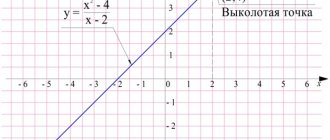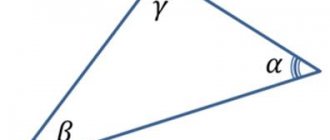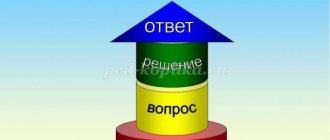Summary of a mathematics lesson in 1st grade “Addition”
Mathematics - 1st grade
Author: Godlevskaya Natalya Borisovna, student of group Sh-31 GBOU SPO "Yeisky Pedagogical College" Description of work: I present to your attention a summary of a mathematics lesson in 1st grade on the topic "Addition" of the educational complex "School 2100", the textbook "My Mathematics" THOSE. Demidova, S.A. Kozlova, A.P. Thin 1 class. 1 part. Lesson 19. Goal: to introduce the arithmetic operation of addition Objectives: 1) educational: to reveal the specific meaning of the action of addition, to teach addition, to introduce the arithmetic signs “+” and “=”, to improve writing skills 2) developmental: to develop logical thinking, oral and written speech, memory, attention 3) educational: to cultivate interest in the subject, camaraderie; instill a love for animals. Equipment: concept cards, handouts for teacher and students (red and blue circles).
Lesson progress
1. Organizational moment Teacher: Hello, guys. The girls sat down quietly, the boys sat down quietly. Let's check your readiness for the lesson. If you have the item I call, clap, and if you don’t, raise your hand. So, let's start: diary, notebook, math textbook, pen, pencil, ruler. 2. Oral counting Teacher: Sit up straight.
Accepted the student's landing. Now listen carefully and get ready to answer. If you know the answer, raise your hand. Problems in verse: A puppy is sitting on the porch, warming his fluffy side.
Another one came running and sat down next to him. (How many puppies are there?) The Hedgehog brought three apples from the garden. He gave the most rosy thing to Belka. The squirrel received a gift with joy. Count the apples on the hedgehog's plate. Teacher: Tell me, guys, can a hedgehog be called a good friend? Why? (the hedgehog gave the squirrel a treat)
Get ready to solve the following problems: 1) Sparrows were jumping along the path: one among two and three in a row, one in front and two behind.
How many sparrows were jumping along the path? (three) 2) The loaf was cut into three parts. How many cuts were made in total? (two) Teacher: Everyone stood up. Let's do some physical education.
My back is straight, (Walk in place, hands behind my back.) I’m not afraid of bending: (Lean forward.) Straighten up, bend over, (Lean back, straighten up.) Turn around. (Turns of the body.) One, two. three. four. Three. four, times. two.
(Lean forward and straighten up.) I walk with a proud posture.
(Turns the torso.) I keep my head straight, (Lean forward and straighten up.) I’m not in a hurry. (Walk in place, hands behind your back.) One. two. three. four, (Turns of the torso.) Three. four, one, two. (Walk in place, hands behind your back.) I can bow. (Bow and straighten up.) And sit down, and bend over, (Squat, bend forward.) Turn back and forth! (Turns the body to the right and left.) Oh, straight back! (Lean forward and straighten up.) One, two, three, four (Turns of the torso.) Three, four, one, two. 3. Updating knowledge Teacher: Guys, name the numbers that you already know. (1,2,3)
Which number is greater, 1 or 2?
2 or 3? 1 or 3? 4. Learning something new Teacher: Open your textbooks on page 38, find exercise 1.
Teacher: Look at Petya’s drawings. How many circles are there in the first picture? (1)
On the second?
(2)
Take the handout.
Place on the table on the left the same number of red circles as Petya has, and on the right – the same number of blue ones. Now put them together. What should you call your actions? (addition)
If we say: came, arrived, gave, brought, collected, then in mathematical language this is called active addition.
How to record your actions? In the language of mathematics, the action is written as follows: 1+2 or 2+1. This action is addition. The "+" sign is called a plus sign. Let's count how many circles you get if you add them up? (3)
3 is the result of adding the numbers 1 and 2. In the language of mathematics it is written like this: 1+2=3 or 2+1=3 The “=” sign is called equal.
And the record itself is called an example. And it reads like this: one plus two equals three or two plus one equals three. The signs “+” and “=” are called arithmetic signs, and addition is an arithmetic operation. 5. Primary consolidation Teacher: Listen to poems about arithmetic signs.
I am a plus.
And that makes me proud. I'm fit for addition. I am a good sign of connection. And that is my purpose. Teacher: What arithmetic sign is this poem about? (+)
What is the plus sign for?
(To denote the action of addition)
And to find out what happens, the equals sign helps.
Teacher: What arithmetic sign is this poem about? (=)
What is the equal sign used for?
(To indicate the result of an action) Teacher: Open your math notebooks. Find today's date. Find the red dot below on the left side of the sheet. Let's start writing in it. The plus sign is written like this. I place the chalk in the middle of the top line of the cell, draw the line down, touch the bottom line of the cell. I take my hand off, put the chalk in the middle of the left cell line, draw the line to the right, touch the right cell line. Move one cell to the right, put a dot. Write the plus sign five times across the box. Move one cell to the right. The equal sign is written like this. I place the chalk just above the middle of the left cage line, draw the line to the right, touch the right cage line, and lift my hand. I place the chalk just below the middle of the left cage line, draw the line to the right, touch the right cage line, and lift my hand. Write the equal sign five times. Teacher: Let's do some physical education.
Oh, how long it took us to write.
Oh, how long it took us to write, The guys’ eyes were tired. {Blink your eyes.) Look out the window, (Look left - right.) Oh, how high the sun is. {Look up.) We’ll close our eyes now, (Close our eyes with our palms.) In class we’ll build a rainbow, we’ll go up the rainbow, {Look in an arc up to the right and up to the left.) Let’s turn right, turn left, and then slide down, (Look down.) Squint your eyes hard, but hold on. (Close your eyes, open and blink them) 6. Consolidation Teacher: Now we will make up examples for the problems. I will read the problem, and you will have to come up with an example for it and write it down. 1) Kolya had an apple. Masha treated him to an orange. How many fruits does Kolya have? (2) Teacher: How many apples did Kolya have? (1) Move one cell down from the previous entry, go to the beginning of the line and write the number 1 in the first full cell. If Masha gave Kolya a treat, then what action is this in mathematical language? (Addition) The addition sign is plus. Place a plus sign in the next cell. How many oranges did Masha give to Kolya? (1) We put one in the next cell. To indicate the result of an action, we put an equal sign in the next cell. Let's solve an example. What is one plus one? (2) In the next cell we put the number 2. 2) Their friend Igor came to the twins Kirill and Philip. How many boys played together? (3) Teacher: How many boys were waiting for a friend to visit? (2) Move a cell down from the first number of the first example and write the number 2. If a friend came to the boys, what action is this in mathematical language? (Addition) The addition sign is plus. Place a plus sign in the next cell. How many boys came to visit? (1) We put the number 1 in the next cell. To indicate the result of the action, we put the equal sign in the next cell. Let's solve an example. What is two plus one? (3) In the next cell we put the number 3. One student goes to the board to write down an example. Teacher: For the next problem, write down an example yourself, with the same reasoning. 3) The girl had one piece of marmalade. Mom and Dad bought her more marmalade. How many sweets did the girl have? Teacher: From the last example, move one cell down. Under the first number of the second example we begin to write. Let's check. One student reads his example, the rest check it. Teacher: Take your textbooks, find exercise 8 on page 39.
Let's read the task in chorus. Teacher: Look at the figures that the guys drew. What figures did Katya draw? Peter? Vova? Look at the cards with numbers underneath them. How many figures did Katya draw? Vova? Peter? 7. Summing up Teacher: Our lesson has come to an end. Answer my questions: 1) What arithmetic operation did we learn about today? 2) What arithmetic signs did we meet today? 3) What numbers did we remember today? 4) What figures did we remember today? 8. Reflection Teacher: For those who did well in the lesson today, for whom the lesson was easy and interesting, draw a cheerful smiley face in the margin. For those who did not succeed in the lesson, but liked the lesson, draw a calm smiley face in the margin. For those who didn’t succeed, the lesson didn’t arouse interest, draw a sad emoticon
We recommend watching:
Solving and preparing simple problems in 1st grade Lesson notes - fairy tales in mathematics in 1st grade Lesson notes in mathematics in 1st grade Math lesson notes for 1st grade
Similar articles:
Lesson summary in mathematics in 1st grade according to the Federal State Educational Standard
Math lesson notes for 1st grade
Summary of a mathematics lesson in 1st grade
Summary of a mathematics lesson in 1st grade. Number 9, number 9
Lesson notes on mathematics in 1st grade (UMK "Harmony")
Online tests in mathematics for 1st grade
Here you can find online math tests in which your child will be able to solve problems for 1st grade, as well as complete addition and subtraction tasks.
Mathematical problems are compiled taking into account the school curriculum for 1st grade. The tasks present actions for adding and subtracting single-digit numbers: 5+3, 8-4, 2+2, and actions for adding and subtracting two-digit numbers with single-digit numbers: 10 + 7, 17 – 7, 17 – 10.
Among the tests presented there are tasks for 1st grade, both with one action and with two actions. Of course, your child will first need to practice their math skills with single-action problems. And when the child can solve them easily, feel free to move on to more complex tasks in two steps. The main thing is that the training proceeds incrementally, then the result will be much higher and more effective.
For any child, problems are always more difficult than examples. Since in them you need not only to solve an example, but also to compose this example based on a given condition. And this requires logical and imaginative thinking.
Addition and subtraction tests are great for training your child's math skills and mental math skills. The more often a child exercises, the higher his performance in school will be. The tests are based on what a child should know and be able to do in 1st grade. This includes: Numbers from 1 to 10, Numbering of numbers, Addition and subtraction from 0 to 10 and from 10 to 20, Comparison of numbers, Unit of time: hour, Units of length: centimeter, decimeter, Ratio between them, Unit of mass: kilogram, Unit capacity: liter, Signs + (plus), – (minus), = (equal), Names of components and results of addition and subtraction (their use when reading and writing numerical expressions).
Now you can take all the online math tests for grade 1 in order. Be careful!
Tests
Test No. 1. Math problems - Finding the sum, 1st grade .
… ↓ Here you must solve mathematical problems to find the sum for 1st grade. The test contains 10 task questions
Test No. 2. Math problems - Finding the sum, 1st grade . … ↓
Here you must solve mathematical problems to find the sum for grade 1, part 2. The test contains 10 task questions
Test No. 3. Math problems - Finding the sum, 1st grade . … ↓
Here you have to go through math problems to find the sum for grade 1, part 3. The test contains 10 task questions
Test No. 4. Math problems - Finding the remainder, 1st grade . … ↓
Here you have to go through math problems for finding remainder for 1st grade. The test contains 10 task questions
Test No. 5. Math problems - Finding the remainder, 1st grade . … ↓
Here you have to solve mathematical problems to find the remainder for grade 1, part 2. The test contains 10 task questions
Test No. 6. Math problems - More, less, 1st grade . … ↓
Here you have to solve math problems on the topic “More, Less” for 1st grade. The test contains 10 task questions
Test No. 7. Math problems - More, less, 1st grade . … ↓
Here you must solve mathematical problems on the topic “More, less. Part 2" - for 1st grade. The test contains 10 task questions
Test No. 8. Mathematical problems - Finding the unknown addend and subtrahend, 1st grade . … ↓
Here you must solve mathematical problems on the topic “Finding an unknown addend and subtrahend” - for 1st grade. The test contains 10 task questions
Test No. 9. Mathematical problems - Finding the unknown addend and subtrahend, 1st grade . … ↓
Here you must solve mathematical problems to find the unknown addend and subtrahend for grade 1, part 2. The test contains 10 task questions
Test No. 10. Math problems - Finding an unknown minuend, 1st grade . … ↓
Here you have to solve mathematical problems to find an unknown minuend for 1st grade. The test contains 10 task questions
Test No. 11. Math problems - Finding an unknown minuend, 1st grade . … ↓
Here you must solve problems on finding an unknown minuend for grade 1, part 2. The test contains 10 questions
Test No. 12. Math Problems - Difference Comparison, Grade 1 . … ↓
Here you have to solve difference comparison problems for 1st grade. The test contains 10 task questions.
Test No. 13. Math problems with indirect questions, grade 1 . … ↓
Here you have to solve math problems with indirect questions for class 1. The test contains 10 task questions
Test No. 14. Number order from 1 to 10, grade 1 . … ↓
In this test you must restore the correct order of numbers by inserting the missing digit into a number line. The test has 20 questions.
Test No. 15. Neighbors of numbers up to 10, grade 1 . … ↓
Here you must determine the neighbors of each given number (i.e. to the left and to the right of it in the number series). The test contains 20 questions
Test No. 16. Composition of numbers from 2 to 10, grade 1 . … ↓
Here you must complete tasks on the composition of numbers from 2 to 10 for 1st grade. The test contains 20 questions
Test No. 17. Ordinal counting from 0 to 10, grade 1 . … ↓
Here you must correctly complete tasks on ordinal counting from 0 to 10 for 1st grade. The test contains 20 questions
Test No. 18. Ordinal counting from 10 to 20, grade 1 . … ↓
Here you can test your knowledge of ordinal counting from 10 to 20 for 1st grade. The test contains 20 questions
Test No. 19. Mathematical dictation - Addition and subtraction up to 10, grade 1 . … ↓
Here you can take a mathematical dictation - on addition and subtraction up to 10 for 1st grade. The test contains 20 questions
Test No. 20. Mathematical dictation - Addition and subtraction up to 20, 1st grade . … ↓
Here you can take a mathematical dictation on addition and subtraction up to 20 for 1st grade. The test contains 20 questions
Test No. 21. Solving mathematical expressions up to 10, grade 1 . … ↓
Here you have to solve all the math expressions up to 10 for class 1. The test contains 20 questions
Test No. 22. Solving mathematical expressions up to 20, 1st grade . … ↓
Here you have to solve math expressions up to 20 for class 1. The test contains 20 questions




